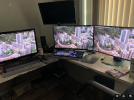I've needed a new 4k monitor for some time. Native resolution for 4k monitors (27") seems to be universally 3840 x 2160. Most decent monitors claim to have 90%+ RGB, but there are other claims to having 100% Rec 709 compliance and "factory calibration". Some have USB-C ports, etc. I guess what I'm asking is, for my needs, which features are needed and which are overkill? I guess I'm asking if I need to return the monitor I recently purchased and "upgrade" to a more expensive monitor. or not? The comparison current is a Dell S2721QS retail $399 vs an ASUS ProArt PA279CV retail $499. Were it only $100 difference there would be no question.
When shopping at Micro Center, there was a Dell S2721QS open box for $271 (out the door w/tax $300). The monitor with all the bells and whistles was the ASUS, which would be $450 w/tax. Is the $150 meaningful? In the larger scheme no, but does it have anything more I need for the extra money?
I own an i1Profiler colorimeter and software and dutifully calibrated the monitor. The RGB controls needed a very minor tweak and reference images show blacks as black and whites neutral, though the brightness in my experience has much to do with the brightness of the room. Brightness and contrast seem ok as the whites seem bright enough and with similar settings my other Dell monitor (FHD) which is duplicated (and also calibrated) shows a little highlight blooming in skin highlights where the new one is still retaining detail. The 2721 is showing more detail definition than the FHD Dell, which would be expected and seems to be even corner to corner. At least if there is any discrepancy I'm not seeing it. . It has display port and HDMI ports. I don't see a need for USB-c.
I guess what I'm asking is, will spending more money on the ASUS or other monitor bring me any increase in detail or color accuracy that I would see? I know that in terms of monitors the prices can get ridiculous if I went with a higher end BenQ or an Eizo or some others. I'm not doing high end production and most of what I produce is going to mostlly be consumer level stuff, the most intense probably doing some real estate work in the furture (except it pays bubkes around here).
So tell me what you guys think? Exchange for the Dell for the ASUS or aim at an even higher price point? If so, why?
When shopping at Micro Center, there was a Dell S2721QS open box for $271 (out the door w/tax $300). The monitor with all the bells and whistles was the ASUS, which would be $450 w/tax. Is the $150 meaningful? In the larger scheme no, but does it have anything more I need for the extra money?
I own an i1Profiler colorimeter and software and dutifully calibrated the monitor. The RGB controls needed a very minor tweak and reference images show blacks as black and whites neutral, though the brightness in my experience has much to do with the brightness of the room. Brightness and contrast seem ok as the whites seem bright enough and with similar settings my other Dell monitor (FHD) which is duplicated (and also calibrated) shows a little highlight blooming in skin highlights where the new one is still retaining detail. The 2721 is showing more detail definition than the FHD Dell, which would be expected and seems to be even corner to corner. At least if there is any discrepancy I'm not seeing it. . It has display port and HDMI ports. I don't see a need for USB-c.
I guess what I'm asking is, will spending more money on the ASUS or other monitor bring me any increase in detail or color accuracy that I would see? I know that in terms of monitors the prices can get ridiculous if I went with a higher end BenQ or an Eizo or some others. I'm not doing high end production and most of what I produce is going to mostlly be consumer level stuff, the most intense probably doing some real estate work in the furture (except it pays bubkes around here).
So tell me what you guys think? Exchange for the Dell for the ASUS or aim at an even higher price point? If so, why?











